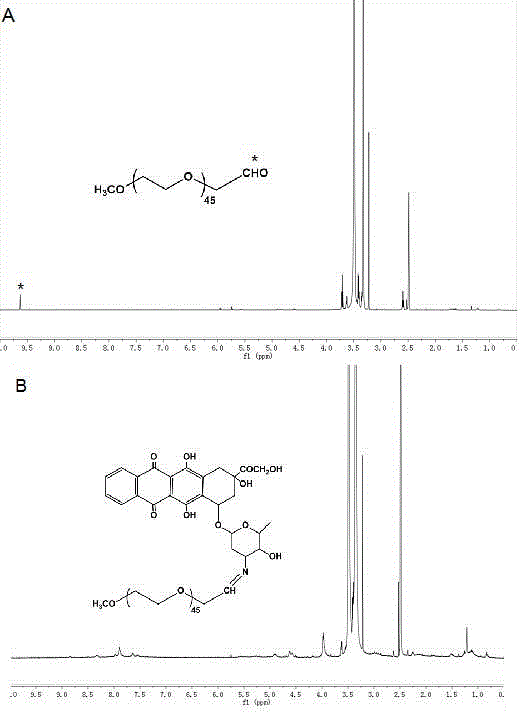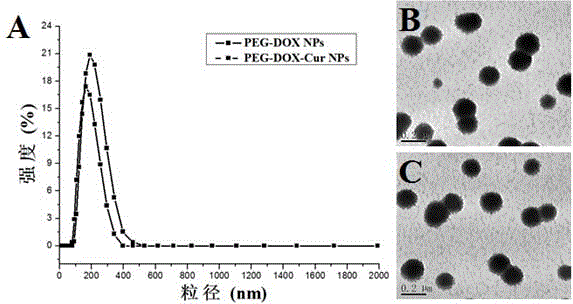pH sensitive nanoparticles prodrug with capacity of co-delivering multiple drugs, preparation method and application thereof
A nanoparticle and co-delivery technology, applied in the fields of polymer chemistry and biomedical engineering, can solve the problems of toxic side effects, low drug loading, slow release rate, etc., to ensure the consistency of in vivo kinetics, improve drug loading capacity, The effect of enhancing stability
- Summary
- Abstract
- Description
- Claims
- Application Information
AI Technical Summary
Problems solved by technology
Method used
Image
Examples
Embodiment 1
[0047] figure 1 It is a schematic diagram of the pH-sensitive nanoparticle prodrug of the embodiment of the present invention. from figure 1 It can be seen from the figure that the double sensitive layer cross-linked nanoparticles of the present invention have a three-layer structure, the outer layer is PEG with high biocompatibility, the inner core is the anti-tumor drug DOX bonded to the hydrophilic end, and then wrapped by hydrophobic interaction Another hydrophobic antineoplastic drug Cur.
[0048] (a) Preparation of pH-sensitive nanoparticle prodrugs
[0049] Weigh 200 mg of mPEG-CHO (Methoxy-poly(ethylene glycol)-aldehyde) with a molecular weight of 2000 and 50 mg of doxorubicin (DOX), dissolve them in 2.0 mL of dimethyl sulfoxide (DMSO), add 20 μL of triethylamine was used as a catalyst, and the reaction was shaken in a water bath at 40 °C for 24 h. The solution was placed in a dialysis bag with a molecular weight cut-off of 1 KDa, and DMSO was used as the dialysat...
Embodiment 2
[0056] Sensitivity characterization of PEG-DOX-Cur NPs, the specific steps are as follows:
[0057] The prepared PEG-DOX-Cur NPs were placed in an acidic solution with pH 5.0 and incubated in a constant temperature oscillator at 37°C for 48 h, and the changes in particle size and morphology were detected by laser particle size analyzer and transmission electron microscope. Test results such as Figure 4 As shown in A, the particle size of the nanoparticle prodrug increased significantly at 24 h and 48 h, and the scanning electron microscope showed that the nanoparticle disintegrated at 48 h, and its shape was very irregular ( Figure 4 C).
Embodiment 3
[0059] The in vitro release behavior characterization of PEG-DOX-Cur NPs, the specific steps are as follows:
[0060] Take 5 mL of PEG-DOX-Cur NPs and encapsulate them in a dialysis bag with a molecular weight cut-off of 3500 Da, add 40 mL of dialysate, the dialysate is a phosphate buffer solution with a pH of 7.4, 6.5, and 5.0, and release it at a constant temperature of 37 °C. in the oscillator. At the predetermined time point, take out 5 mL of release solution and add the same volume of fresh release solution. The amount of drug released was measured by UV spectrophotometer.
[0061] The evaluation results of release behavior are as follows: Figure 5 As shown, DOX and Cur exhibit similar release curves, because the Schiff base bond is an acid-responsive cleavage bond, which leads to the cleavage between PEG and DOX, and the hydrophobic interaction between the nanoparticle prodrug and Cur disappears, that is, in When the nanoparticle prodrug disintegrates, all loaded dru...
PUM
 Login to View More
Login to View More Abstract
Description
Claims
Application Information
 Login to View More
Login to View More - R&D
- Intellectual Property
- Life Sciences
- Materials
- Tech Scout
- Unparalleled Data Quality
- Higher Quality Content
- 60% Fewer Hallucinations
Browse by: Latest US Patents, China's latest patents, Technical Efficacy Thesaurus, Application Domain, Technology Topic, Popular Technical Reports.
© 2025 PatSnap. All rights reserved.Legal|Privacy policy|Modern Slavery Act Transparency Statement|Sitemap|About US| Contact US: help@patsnap.com



